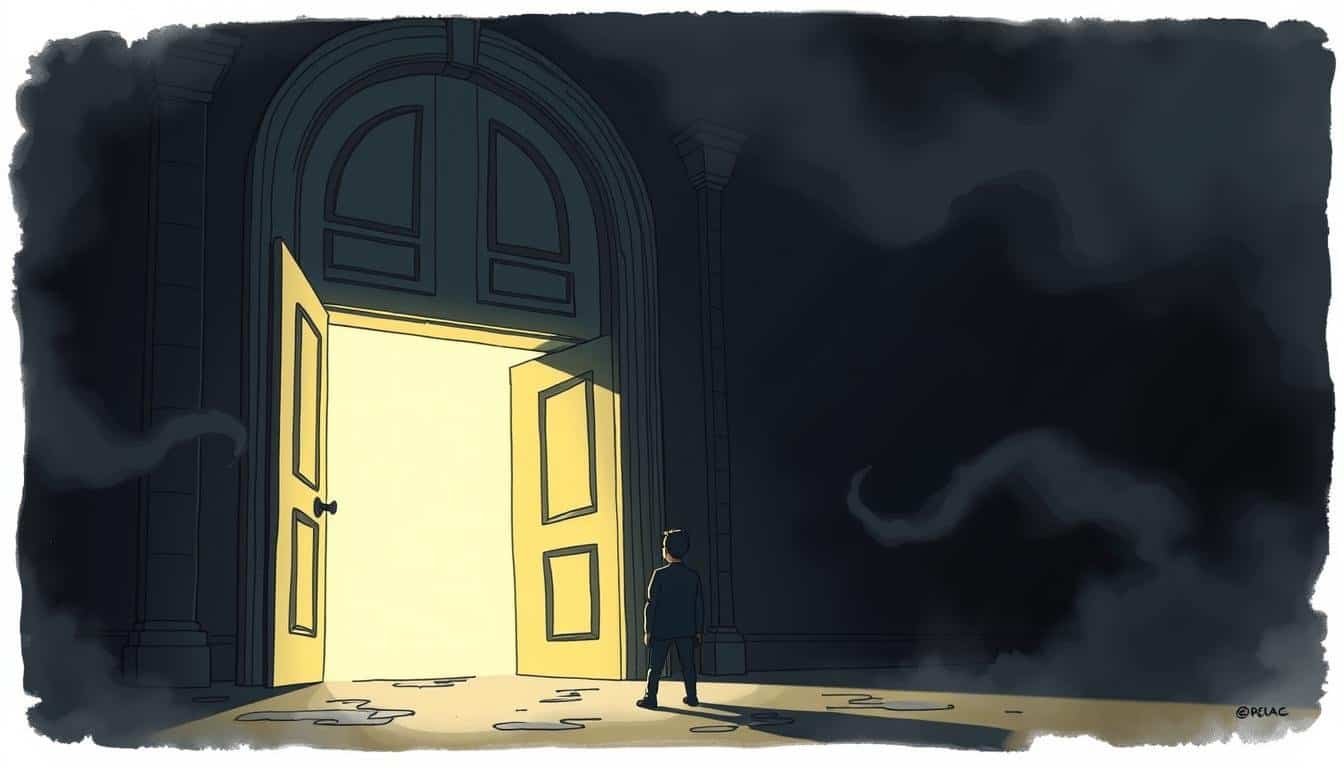Door-in-the-Face Technique: Persuasion Tactics
Have you ever noticed how some requests start big but then get easier? The Door-in-the-Face Technique uses this idea. It makes a big, often crazy first ask. Then, a smaller, more reasonable ask follows, making people more likely to agree.
This method is rooted in how our minds work. It’s about making a big ask to make a smaller ask seem okay by comparison. We’ll dive into how this works, its history, and why it’s effective in getting people to say yes.
Key Takeaways
- The Door-in-the-Face Technique involves making an unreasonable initial request to increase compliance with a follow-up request.
- It is based on principles of reciprocity and social psychology, enhancing the effectiveness of influence tactics.
- Research supports the efficacy of this technique, including studies by Robert Cialdini.
- Relationship dynamics significantly affect the success of this compliance technique.
- Timing between requests can enhance compliance rates.
Understanding the Door-in-the-Face Technique
The Door-in-the-Face Technique is a powerful way to get people to agree with you. It starts with a big ask that people usually say no to. Then, it asks for something more reasonable. This makes the second request seem easier and more appealing, so people are more likely to say yes.
Studies show how well this method works. For example, asking people to be a counselor at a youth center got an 83% no. But when they were asked to go on a trip to the zoo with delinquents, 51% said yes. This shows how the Door-in-the-Face Technique can really make a difference.
This technique is useful in sales and talking to people one-on-one. A big study found that using the Door-in-the-Face method in sales makes sellers more open to big requests. It shows how knowing how to persuade can change how negotiations go.
But, we need to be careful with this technique. If sellers feel manipulated, they might not trust you in the future. Knowing when to use persuasion and when to stop is key to doing well in conversations.
Origins of the Door-in-the-Face Technique
The Door-in-the-Face Technique has its roots in social psychology from the 1970s. Robert Cialdini led the research, looking into how people react to different requests. He found that a big ask, even if turned down, makes people more likely to say yes to smaller requests later.
In a study with 710 people, a big ask was often met with a no. But then, many said yes to smaller requests. This shows how our minds work when making decisions, a key part of behavioral psychology.
This technique is useful in marketing, negotiation, and health campaigns. It helps us understand how to get people to agree to things. Studying it helps us see how it works in different situations.
How the Door-in-the-Face Technique Works
The Door-in-the-Face Technique starts with a big, unreasonable request. This big ask is likely to be turned down. Then, a smaller, more reasonable request follows. This method uses the idea of reciprocity. When you make a smaller ask after a big one, people feel they should say yes to the smaller one.
Many studies show how well this persuasion technique works. For example, Robert B. Cialdini found that only 13% of students agreed to help with juvenile delinquents right away. But after the Door-in-the-Face Technique, 50% agreed. This shows how much more people say yes when asked this way.
When you make two requests, one big and one small, it helps you persuade better. If the first ask is big but not crazy, the second ask seems easier. Experts say to make sure the requests match what the audience wants for the best results.
This technique is great for getting people to agree and even to help out again later. But, using it too much can backfire. People might say no to both requests and trust you less. So, it’s important to plan and use it wisely, especially when you care about being ethical.
The Psychology Behind the Door-in-the-Face Technique
The door-in-the-face technique works well because of deep psychological ideas. These ideas affect how people see and react to requests. A big part of this is the reciprocity principle.
When people face a big ask first, they often want to say yes to a smaller request later. This makes them want to balance things out and keep things fair.
Reciprocity Principle in Persuasion
The reciprocity principle is a strong motivator in the door-in-the-face method. When someone asks for a lot and then asks for less, people might feel they must say yes. Cialdini’s studies show this principle is a strong social rule that makes people want to return favors.
Feeling guilty after saying no to the big ask can make people want to say yes to the smaller one. This helps them feel better.
Influence of Guilt on Compliance
Guilt is a big part of this effect. Saying no to the big request can make people feel bad. This feeling can push them to say yes to the smaller request.
By knowing how guilt affects us, people can use it to get more yeses. Making the requests really stand out from each other makes them work better. This uses these psychological tricks well.
Examples of the Door-in-the-Face Technique in Everyday Life
The Door-in-the-Face Technique is used in many real-life situations, especially in sales and family settings. It shows how powerful this method can be.
Negotiations and Sales Scenarios
In sales, this technique uses contrast. A salesperson might first ask for a very high price. Then, they offer something more reasonable later. For example, a car dealer might show a luxury car at a high price. If the buyer says no, they might offer a cheaper model, making it more likely to sell.
Interactions in Family Dynamics
In families, this technique is also used. A parent might ask a child to do a big task, like clean the whole house. If the child says no, the parent might ask for a smaller task, like cleaning their room. This often leads to the child doing the task, seeing it as a smaller favor.
Studies show that starting with a big request can make people more likely to agree to a smaller one later. This is because we feel we should return a favor when someone makes a concession. The first big request must seem genuine for the technique to work well.
| Scenario | Initial Request | Subsequent Request | Compliance Rate |
|---|---|---|---|
| Sales Interaction | $50,000 luxury car | $30,000 sedan | Increased compliance from initial decline |
| Family Interaction | Clean the whole house | Tidy your room | Higher likelihood of compliance |
The Door-in-the-Face Technique vs. Foot-in-the-Door Technique
The Door-in-the-Face Technique and Foot-in-the-Door Technique are two different ways to persuade people. They use different tactics to get people to agree, which is useful in many situations.
The Door-in-the-Face Technique starts with a big ask that people usually say no to. For example, asking for a big donation and expecting no. Then, a smaller request comes next, which seems easier to agree to. This makes people feel they should say yes to the smaller request.
On the other hand, the Foot-in-the-Door Technique begins with a small ask that people are likely to agree to. After they say yes, a bigger request is made. This method works because people like to keep their promises.
| Technique | Description | Psychological Mechanism |
|---|---|---|
| Door-in-the-Face Technique | Starts with a large initial request followed by a smaller request. | Contrast and reciprocity create a feeling of obligation. |
| Foot-in-the-Door Technique | Begins with a small request leading to a larger request. | Consistency encourages compliance by leveraging prior agreement. |
Studies show that the Door-in-the-Face Technique works better in some cases. For example, it got 90% of students to agree to a big task. In contrast, the Foot-in-the-Door Technique got 60% agreement. Knowing these differences can help you persuade others more effectively.
Research Studies Supporting the Efficacy of the Door-in-the-Face Technique
The Door-in-the-Face (DITF) technique has become a big deal in behavioral psychology. Many studies have looked into how it works and its success in different situations.
Cialdini’s Classic Experiment
In 1975, Cialdini et al. did a study that changed things. They asked people to take a bunch of kids to the zoo for two hours. Then, they asked for a smaller favor. This big ask followed by a smaller one got a 50% yes rate. In groups without the big ask, only 17% agreed. This study showed how powerful the door-in-the-face technique can be.
Recent Findings in Behavioral Psychology
Since then, more studies have backed up Cialdini’s work. A 2020 study in the Journal of Personality and Social Psychology found it still works well. It showed that people are more likely to say yes when asked in a way that feels like helping others.
Studies also looked at how relationships play a part. When friends ask for something, people are more likely to say yes. This shows how important our connections are in making us more open to persuasion.
The table below summarizes key findings from various research studies on the DITF technique:
| Study Year | Key Finding | Compliance Rate (%) |
|---|---|---|
| 1975 (Cialdini et al.) | Initial large request followed by a smaller request led to increased compliance. | 50% |
| 2001 (O’Keefe & Hale) | Effectiveness enhanced in mindless states. | N/A |
| 2020 (Journal of Personality and Social Psychology) | Replicated Cialdini’s findings, confirming the DITF technique’s efficacy. | N/A |
| 2020 (Guilt Study) | High guilt induction significantly increased compliance. | N/A |
Factors Affecting the Success of the Door-in-the-Face Technique
Understanding what makes the Door-in-the-Face technique work is key. Important things like timing, how well people know each other, and how aware the audience is matter a lot. These factors help decide if people will say yes.
Timing Between Requests
How long you wait between big and small requests matters a lot. Waiting a bit can make people more likely to agree. This timing helps people feel fresh and open to the smaller request.
Relationship between Requester and Respondent
How well people know each other is crucial for this technique. Being friends can build trust, making people more likely to help out. When trust is there, people feel they should return the favor, which helps a lot.
Audience Awareness and Customization
Adjusting requests to fit what people like makes it more effective. Knowing what people value and what drives them helps make the request more appealing. This makes the person asking more convincing. Knowing what the audience thinks makes the Door-in-the-Face technique work better.
| Factor | Impact on Compliance |
|---|---|
| Timing Between Requests | A delay enhances receptiveness to smaller requests |
| Relationship Dynamics | Familiarity breeds trust and increases compliance |
| Audience Awareness | Customization leads to stronger persuasion |
Practical Applications of the Door-in-the-Face Technique
The Door-in-the-Face (DITF) technique is useful in sales, marketing, and negotiations. It helps professionals improve their persuasion skills. By asking for a lot at first, they make later offers seem more reasonable.
In marketing, this method works well. Sellers start with a high-cost item, then offer something cheaper. For example, an insurance agent might first suggest a pricey plan, then a more affordable one. This way, customers are more likely to say yes, thanks to the feeling of getting a good deal.
Salespeople use DITF to sway customer choices. Studies show it can boost the chances of getting a yes. When asked to do a big task first, people are more likely to agree to a smaller request later. This method is more powerful than just asking directly.
Negotiators also find this technique helpful. By asking for a lot and then offering less, they can get better deals. It makes the other side feel like they’re getting a good deal, leading to a better agreement.
But, the DITF technique might not always lead to action. A big study looked at 35 years of data and found that agreeing doesn’t always mean doing something. It’s important to tailor your approach to each situation for the best results.
Ethics of Using the Door-in-the-Face Technique
The Door-in-the-Face Technique brings up big questions about its ethics. It can make people agree more easily, but we must use it carefully. We don’t want it to hurt trust or rapport. It’s key to make sure persuasion is helpful, not manipulative.
Avoiding Manipulative Practices
This technique can have bad effects if seen as manipulative. People might feel forced, hurting trust. Trust is vital in all kinds of relationships. Being open and honest with persuasion helps keep things ethical.
This way, we build real connections instead of just getting what we want.
Building Trust and Rapport
Building rapport is key to good interactions. Trust is a big part of getting people to agree. The Door-in-the-Face Method should focus on building a real relationship, not just getting yeses.
When people see the request as real and feel important, they’re more likely to say yes. Making sure people feel respected and building trust makes persuasion ethical.
Conclusion
The Door-in-the-Face Technique is a powerful way to persuade people and get them to agree. It has a success rate of about 50%, showing it’s more effective than other methods. This makes it a great tool for those who communicate with others.
This technique works because it uses psychological principles like reciprocity and consistency. These principles explain why people often agree after a big ask is made, followed by a smaller one.
It’s used in marketing, negotiation, and everyday conversations. By asking for a lot at first and then offering less, people are more likely to say yes. This is true whether you’re asking for donations or trying to make a deal.
But, it’s important to use this technique ethically. Always be clear and respect the other person’s feelings. This way, you can influence others without losing their trust.
Using the Door-in-the-Face Technique wisely can make you more influential. It helps build trust and cooperation. By using it in a fair way, you can succeed in your interactions with others.







